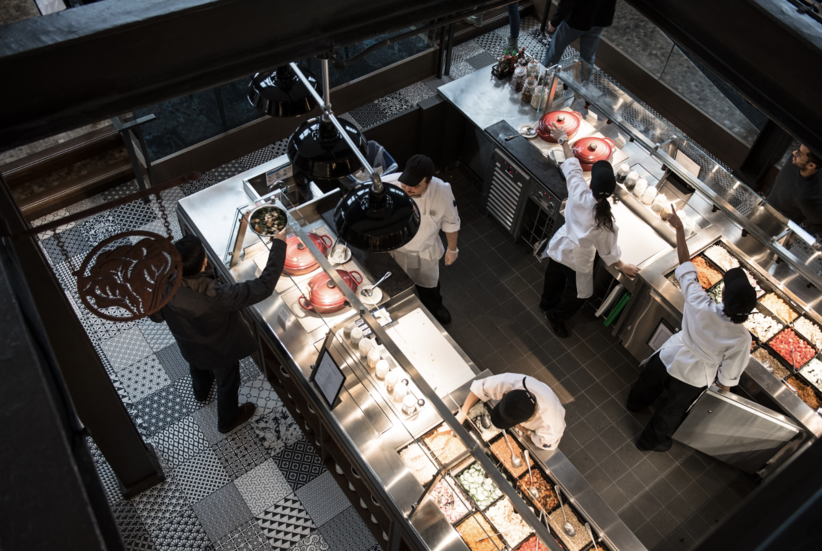Google offers a food-at-work program with the mission to inspire and enable its global workforce to thrive through food choices and experiences. The company is determined to set a new standard for corporate responsibility, showing the world that even companies known for their digital leadership can make a tangible impact on the most fundamental aspects of human life: our food and health.
Malnutrition, encompassing both under- and over-nutrition (deficiencies or excesses in nutrient intake, respectively), impacts more than one billion people worldwide, leading to poor health outcomes and low productivity in the workplace. The office offers an important opportunity to address malnutrition in all its forms, since about 60% of the world’s population spends a third of their time at work.

Google created its Global Food Team to support the company’s 175,000+ employees, in more than 140 cities and 50 countries. This team is responsible for creating food experiences that promote collaboration by engaging and nourishing Googlers every day, through a program called Food at Google. The program is rooted in the premise that food not only has the power to bring people together, but has the ability to improve performance (physical and mental) and overall well-being 1.
With cafes serving thousands of meals per day, and teaching kitchens and events, the team works with a variety of partners and suppliers to deliver delicious, nutritious food and innovative experiences to fuel Google’s culture and future.
“General wellbeing, which of course includes nutrition, has been a part of our culture from the very start,” says Chavanne Hanson, Google’s Food Choice Architecture and Nutrition Lead. “We are becoming more refined in our approach to good food and nutritious eating as we recognize the distinct benefits of health and wellbeing on performance outcomes.”
Creating intentional environments for Googler’s to thrive
Over time, Google developed the Food Choice Architecture (CA) program, which is a research-based Team within Food at Google designed to make “the healthiest choice the easiest choice” for employees, and is rooted in three guiding principles:
- Choice is foundational to the Google food experience
- Healthy choices help Googlers thrive
- Choice architecture can help individuals make better choices.
Google operates an impressive network of 380 cafes and 1,500 MicroKitchens. They are go-to destinations for snacks, healthy beverages and meals. Careful consideration goes into designing these spaces, ensuring a focus on providing a water-forward experience, where healthy beverages like water are more easily accessible and visible than drinks with a high sugar content, like sodas.

Fruits and vegetables take center stage to encourage a shift towards a more balanced and plant-forward diet. This approach aims to address the common issue of inadequate fruit and vegetable consumption, promoting healthier choices and overall wellbeing, both at work and at home. This means Google can have a wider long-term impact, helping Googlers’ families eat better.
Sheryl Allen, Food Choice Architecture Director for ISS Guckenheimer at Google, works to create environments that spotlight sustainable food choices: “Through behavioral science, we can empower individuals to make healthy food choices today that will undoubtedly impact the health and wellbeing of people and the planet in the years to come,” she says. “Change starts small and we need to understand the mechanisms that enable lasting behavior change in order to make our biggest impact.”
Four commitments and clearly defined KPIs
To further enhance the program’s implementation, Google has made four clear commitments:
1. Join the Workforce Nutrition Alliance – The first step was completing the Alliance’s self-assessment scorecards in all four workforce nutrition pillars: Healthy Food at Work, Nutrition Education, Nutrition Health Checks and Breastfeeding Support.
2. Enhance and implement culinary training – Google collaborated with the Culinary Institute of America (CIA) to develop a dual-level plant-forward curriculum initiative that will launch for Google’s culinary leadership teams across the 25 largest sites by the end of 2023.
3. Increase agrobiodiversity of ingredients – The team is working to increase the agrobiodiversity of foods used in food service menus and recipes to 30% from the 2020 baseline of 8%.
4. Promote healthy eating – 40% of the employee teaching kitchen class portfolio will promote dietary diversity and balanced diets through nutrition education, with formats such as cooking classes, farm to table insight sessions and Food Talks, where internal and external food system experts are invited to Google campuses to share their passion, knowledge and skill to advance a more sustainable food system. At the same time, the Global Food Team is implementing the Choice Architecture Guidelines at the largest sites, giving more visibility to healthy options on menus and in cafes and other food spaces.
And here’s the good news: the Global Food Team is well on track to achieve these KPIs. Routine check-ins with the internal team and close monitoring of key metrics is how they stay on track for annual reporting.
“I am responsible for 14 teaching kitchens, where every day we educate our Googlers on how to prepare food and where food comes from,” adds Hanson. “This includes everything from mastery classes to growing food in the garden. We’re really giving our workforce unique and meaningful experiences.”

Google has also extended its training programs to chefs at different levels, employing a “train the trainer” approach. Tailored training addresses specific skill sets, ensuring chefs receive the necessary guidance to excel in their roles.
Healthy food at work
To achieve all of this, Google works with external partners and mission-driven suppliers who are aligned with the pillars of the Choice Architecture program, share the company’s vision of promoting sustainable food practices, and support positively impacting global nutrition. One such significant partnership is with the Workforce Nutrition Program, who founded the Workforce Nutrition Alliance.
Through this partnership, Google aims to be a lighthouse leader for workforce nutrition, making healthy and sustainable eating the norm in workplace food service.
Michiel Bakker, Vice President of Global Workplace Programs at Google, confirmed: “The Workforce Nutrition Alliance has provided a meaningful platform for us to galvanise our efforts around employee wellbeing.”
Moving forward
A key learning for the Global Food Team has been the importance of buy-in from internal stakeholders on all levels and in all geographies. “We have to accept that change in general and changing nutrition habits specifically takes time,” adds Allen. “Therefore, we meet the teams where they are and we actively engage.”
A new Plant-Forward Culinary Training curriculum has been launched across the Americas, Middle East, Europe, and Africa in three languages (English, Spanish, Mandarin). This curriculum, which is also available to the public, will be launching in the Asia Pacific region this Fall. That will be followed by the global roll-out of the updated Food Choice Architecture’s 2.0 standards. When it comes to workplace wellness, the only constant is change in a dynamic and growing environment like Google.
_______
References
